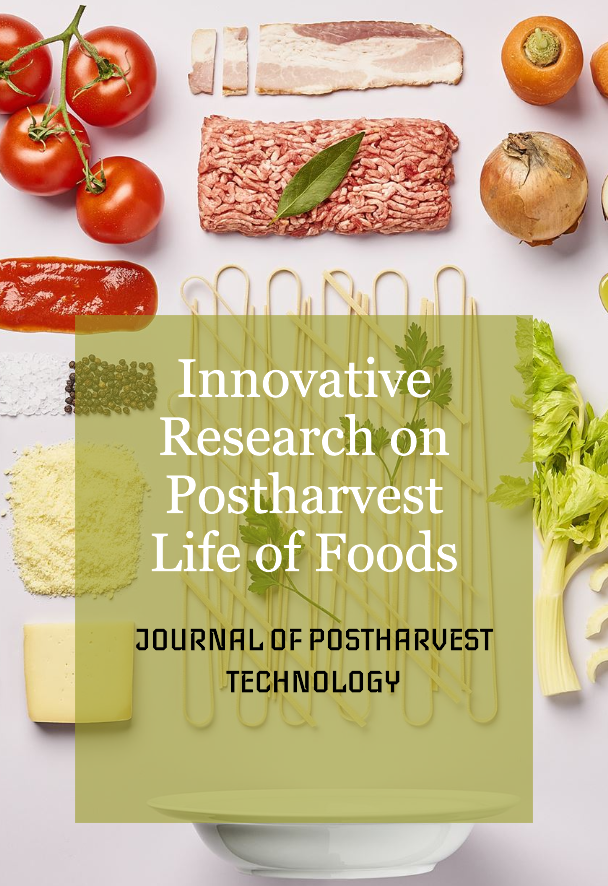Formulation And Sensory Evaluation of Waterchestnut Flour Laddoo
DOI:
https://doi.org/10.48165/jpht.2024.12.2.11Keywords:
Water chestnut flour, Singhara, Trapa natans, Ladoo, Antioxidants, Minerals, Sensory attributesAbstract
After chestnut flour was used to prepare Ladoo by incorporating processed water chestnut through sun drying, water chestnut flour Ladoo was standardized with different percentages of water chestnut flour. The percentages used were 0% (T0 as control), 5% (SDT1), 10% (SDT2), 15% (SDT3), and 20% (SDT4), respectively. Water chestnut flour incorporated Ladoo with 0% water chestnut flour was treated as the control. The nutritional contents of the sun-dried water chestnut flour were evaluated using AOAC methods. The proximate composition of SDT (sun-dried water chestnut flour treatment) for moisture content, protein, fat, total ash, crude fiber, and carbohydrate were 11.02 g, 12.42 g, 3.44 g, 2.93 g, 0.54 g, and 70.19 g, respectively. Water chestnut flour is a potential source of potassium and calcium, with levels of 1298.64 mg/100g and 89.26 mg/100g, respectively. The water chestnut flour showed good antioxidant content. In the evaluation of sensory characteristics of water chestnut Ladoo, a significant difference (P<0.05) was found among all treatments (SDT1, SDT2, SDT3, and SDT4). The differences were observed in terms of appearance/color, texture, taste, flavor, and aftertaste. The various products were also found to be a good source of nutrients, particularly in terms of protein, carbohydrate, minerals, and antioxidants. The incorporation of sun dried water chestnut flour Ladoo with 10% was found to be effective in maintaining better health conditions for everyone.
References
Adkar, P., Dongare, A., Ambavade, S., & Bhaskar, V. H. (2014). Trapa bispinosa Roxb: A Review on Nutritional and Pharmacological Aspects. Advances in Pharmacological Sciences, 959830. https://doi.org/10.1155/2014/959830.
Alfasane, A., Moniruzzaman, K., & Mahbubar Rahman, M. (2011). Biochemical composition of the fruits of water chestnut (Trapa bispinosa Roxb). Journal of Biological Science, 20(1), 95-98.
AOAC. (1990). Official methods of analysis, 15th edn. Association of Official Analytical Chemists, Washington, DC. AOAC. (2000). Official Methods of Analysis, 17th Ed. Association of Official Analytical Chemists, Washington D.C.
Baba, N. W., Rashid, I., Shah, A., Ahmad, M., Gani, A., & Masoodi, F. A. (2014). Effect of microwave roasting on antioxidant and anti-cancerous activities of barley flour. J. Saudi Soc. Agric. Sci., 27, 143–154.
Chenlo, F., Moreira, R., Pereira, G., & Silva, C. C. (2007). Evaluation of the rheological behaviour of chestnut (Castanea sativa mill) flour pastes as a function of water content and temperature. Electronic Journal of Environmental, Agriculture and Food Chemistry, 6(2), 1794–1802.
Demirkesen, I., Mert, B., Sumnu, G., & Sahin, S. (2010). Utilization of chestnut flour in gluten-free bread formulations. Journal of Food Engineering, 101(3), 329-336.
Gupta, A., & Awasthi, M. (2021). Formulation of Water Chestnut Flour and Ragi Flour Biscuits for Celiac Patients and Study on Their Nutritional Attributes and Sensory Evaluation. Indian Journal of Nutrition, 8(1), 220.
Hussain, S. Z., Beigh, M., Qadri, T., Ahmad, I., & Naseer, B. (2020). Development of low glycemic index crackers from water chestnut and barley flour. British Food Journal, 122(4), 1156-1169. https://doi.org/10.1108/BFJ-10-2019-0788.
Jan, U., Gani, A., Ahmad, M., Shah, U., Baba, W. N., Masoodi, F. A., Maqsood, S., Gani A., Wani, I. A., & Wani, S. M. (2015). Characterization of cookies made from wheat flour blended with buckwheat flour and effect on oxidant properties. J. Food Sci. Technol., 52(10), 6334–6344.
Krishnaiya, R., Kasar, C., & Gupta, S. (2016). Influence of water chestnut (Trapa natans) on chemical, rheological, sensory, and nutritional characteristics of muffins. Journal of Food Measurement and Characterization, 10(2), 210-219.
Sacchetti, G., Pinnavaia, G. G., Guidolin, E., & Dalla-Rosa, M. (2004). Effects of extrusion temperature and feed composition on the functional, physical, and sensory properties of chestnut and rice flour-based snack-like products. Food Research International, 37, 527–534.
Singh, A., Ram, C., Meena, N. K. P., Rouphael, Y., Basile, B., & Kumar, P. (2022). Underutilized Fruit Crops of Indian Arid and Semi-Arid Regions: Importance, Conservation and Utilization Strategies. Horticulturae.
Yasuda, M., Yasutake, K., Hino, M., Ohwatari, H., Ohmagari, N., Takedomi, K., Tanaka, T., & Nonaka, G. I. (2014). Inhibitory effects of polyphenols from WC (Trapa japonica) husk on glycolytic enzymes and postprandial blood glucose elevation in mice. Food Chemistry, 165, 42–49. Doi: 10.1016/j.foodchem.2014.05.083.
Yu, L., Nanguet, A. L., & Beta, T. (2013). Comparison of antioxidant properties of refined and whole wheat flour and bread. Antioxidants, 2, 370–383. doi: 10.3390/antiox2040370.




